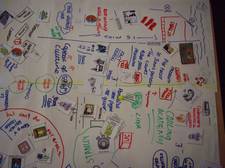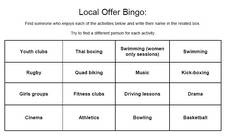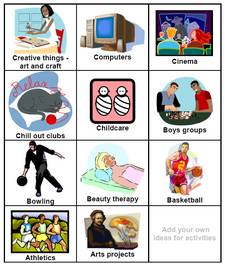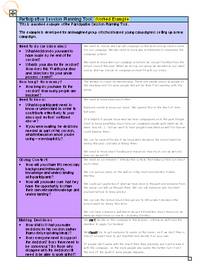 I recently co-designed and fascilitated a series of dialogue events for The National Youth Agency (NYA) between young people, officials from the Department for Education and Skills (DfES) and Parmjit Dhanda MP (then Minister for Children and Families). We focussed the dialogues, which were part of a broader UK tour by Parmjit Dhanda, on the Local Offer.
I recently co-designed and fascilitated a series of dialogue events for The National Youth Agency (NYA) between young people, officials from the Department for Education and Skills (DfES) and Parmjit Dhanda MP (then Minister for Children and Families). We focussed the dialogues, which were part of a broader UK tour by Parmjit Dhanda, on the Local Offer.
The Local Offer is a guarantee introduced through Section 6 of the Education and Inspections Act that gives young people the right to:
- Two hours recreational leisure activity a week
and
- Two hour education leisure activity a week
This should be out of school, and local authorities are responsible for making sure there is provision, it is well publicised, and that young people can access it. Young people should also be involved in influencing what is provided under the Local Offer.
As we had three-hours for the dialogues, the first two with mainly young people – and the third with extra DfES officials and the Minister, we designed a process that:
- Introduces the local offer
- Creates a map of current provision under the local offer
- Opens up discussions about how young people want to influence the activities that are provided, and how they think local authorities should be held to account for ensuring provision
- Explores some of those methods of influence and accountability in more depth – exploring how potential barriers might be overcome.
The resources we developed for the session are fairly flexible – and so I thought I would share them here – as they may well be useful to local areas exploring the local offer, or others running consultation processes related to activity provision for young people.
I’ve included a bit of description about how we used the resources – but you are free to take them and adapt them as you wish. If you do make use of them, I’d be really grateful if you could drop me a line or leave a comment to share news of how… (tim@practicalparticipation.org.uk)
I’ve also suggested possible modifications to the resources… if you do make any of these, please do share your updated resources as well…
Local Offer Bingo: a name game
 We used this set of 10 ‘Local Offer Bingo’ cards as our ice-breaker name-game.
We used this set of 10 ‘Local Offer Bingo’ cards as our ice-breaker name-game.
Simply give everyone a card, and ask them to talk to each other and to write down someones name against an activity if that person enjoys that particular activity. Each name can only be used once, and you need to find someone for each of the 16 squares on the card. The first person to fill their card (i.e. to find 16 people’s names) shouts Bingo!
After you’ve completed the name game – you can use it to take about the sort of activities people enjoy – and how they now have a right to positive activities in their areas because of the local offer.
The list of activities came from young peoples suggestions in an earlier NYA consultation on Youth Matters.
You can download the cards for printing as a PDF, or for modification as a Word Document.
Possible modifications: Add images to the bingo cards like in the local offer cards below…
Local Offer Cards
 These cards add a bit of colour, and list all 47 of the activities used in Local Offer Bingo along with a suitable clip-art image.
These cards add a bit of colour, and list all 47 of the activities used in Local Offer Bingo along with a suitable clip-art image.
We used the cards for a community mapping excercise during which:
- We asked groups to draw out key landmarks in their communities
- We then asked the group to draw places where they did stuff
- We then asked groups to pick up Local Offer Cards that represented things they enjoyed doing, and to place them on the map if there were places where they could carry out that activity.
- We used the picture that built up to shape discussions around what was and wasn’t available in the local areas members of the group came from.
We also had some stickers with icons and words relating to different barriers that might stop young people accessing activities. Things like ‘cost’, ‘transport’, ‘time’, ‘traffic’ and ‘attitudes of adults’. For some groups we asked them to add these on top of the map to show where barriers to accessing activities existed.
The cards and mapping excercise were really useful in starting discussions and making sure that everyone could have a say, regardless of whether they were comfortable with the written word and verbal expression or not. I’m sure there are many other uses for the cards as well as in mapping; for example, using them to prioritise the different sorts of activities a group would be interested in having provided, or adding ‘costs’ to them and getting a group to try a budgeting excercise thinking about how they would ensure provision of a wide range of activities.
You can download the cards for printing as a PDF for printing, or for modification as a Word Document.
Possible modifications: Give each card a ‘cost’ score according to how expensive or resource intensive that activity is to provide (like in David Wilcox’s Social Media Game) and encourage a group to try an budgeting excercise to work out where their activity priorities lie.
Problem solving chart
 This is a really simple tool – and I was suprised by how well it worked.
This is a really simple tool – and I was suprised by how well it worked.
In our sessions we held an idea-storm with the group to ask:
- How could you influence local authority decisions about provision under the local offer?
- How could you hold responsible decision makers to account for provision under the local offer?
(we used different ‘translations’ of the questions depending on the focus that had emerged earlier in the dialogues… but these are the overarching questions we were getting at).
With the results of the idea storm, we picked out key themes for further exploration and then held an ‘open space’ style series of conversations around these themes. We ended up with conversations on themes like:
- Holding meetings with a wide range of local offer stakeholders and young people invited
- Using the law to hold decision makers to account
- Creating a bond between young people and councillors so neither can spend money on activities without the others say so
We wrote the themes in the header box of these problem solving charts that we’d had printed on A1 before the event (rather than just scribbling them up on flip-chats) and, after introducing the charts, asked members of the dialogue to select which theme they wanted to discuss and to go over and have a conversation around it. As fascilitators, we just stepped back.
The charts appeared to really help most groups self-fascilitate and to record some really good points. In particular, encouraging the group to answer the question “What would this look like in practise?” with a narrative about how their ideas would work really helped them to work through the other boxes on the chart.
The charts could easily be used in other contexts and could be adapted with different questions – although I think that:
- Having the charts properly printed up on large paper
and
- Having the first question invite a narrative
were important elements of the charts working as well as they did. They cost us just £1 each to get printed on A1, which was well worth it.
You can download the chart as a PDF here, or as a Word document for modifying.
Recording the dialogues
OK – so this isn’t a tool we created – but it was a tool we used. At each dialogue we took digital photos of all the flip-charts, community maps and recording charts and posted them on the photo-sharing website Flickr. That way we could easily share with others the authentic input given through the dialogues – with a clear accountable record of what went on…
Plus, if we were feeling really fancy, we could annotate all the photos, ‘geo-tag’ them to add them to a map to show the areas they represent, and could easily create a slideshow of them ideal for presenting to local authority officers or councillors with next-to-no extra work…
Attachment: Local Offer Activity Cards.pdf
Attachment: Designing for change.pdf
Attachment: Local Offer Bingo Cards.pdf
Attachment: Designing for change.doc
Attachment: Local Offer Bingo Cards.doc
Attachment: Local Offer Activity Cards.doc

 I recently co-designed and fascilitated a series of dialogue events for
I recently co-designed and fascilitated a series of dialogue events for  We used this set of 10 ‘Local Offer Bingo’ cards as our ice-breaker name-game.
We used this set of 10 ‘Local Offer Bingo’ cards as our ice-breaker name-game. These cards add a bit of colour, and list all 47 of the activities used in Local Offer Bingo along with a suitable clip-art image.
These cards add a bit of colour, and list all 47 of the activities used in Local Offer Bingo along with a suitable clip-art image. This is a really simple tool – and I was suprised by how well it worked.
This is a really simple tool – and I was suprised by how well it worked.